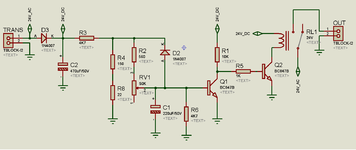gauravkothari23
Advanced Member level 2
Hi All.
I have built a timer circuit using Transistor. (Circuit Diagram Attached)
The power source is 24V 3 Amps Transformer. and i am operating a 24V 10 RPM AC Motor for one of my application.
On Power ON, The motor will be ON for a specific period of time and the time is decided by C1 Capacitor and R2 and RV1 Resistor. as soon as the voltage at transistor base Q1 is close to 0.7V, the transistor goes ON and motor goes OFF. To restart the motor, the Mains power has to be switched OFF and ON Again.
R4 and R8 are used with D2 diode to discharge the power left in C1 after Mains are switched OFF.
what my problem is, suppose at first power ON, the motor stays ON for 5 Seconds. Later when the mains are put to OFF and ON again, the motor goes OFF in hardly 2 seconds, because of C1 capacitor which stays charged. Have noticed that the capacitor C1 takes around 8 to 10 seconds for complete discharge. so in such case, i cannot Restart the Motor for next 10 to 12 seconds and have to wait for capacitor to get discharge.
How can i discharge the Capacitor C1 fast say within 2 seconds.
Putting the mains OFF and ON is the only option what i have to provide to restart the motor.
I have built a timer circuit using Transistor. (Circuit Diagram Attached)
The power source is 24V 3 Amps Transformer. and i am operating a 24V 10 RPM AC Motor for one of my application.
On Power ON, The motor will be ON for a specific period of time and the time is decided by C1 Capacitor and R2 and RV1 Resistor. as soon as the voltage at transistor base Q1 is close to 0.7V, the transistor goes ON and motor goes OFF. To restart the motor, the Mains power has to be switched OFF and ON Again.
R4 and R8 are used with D2 diode to discharge the power left in C1 after Mains are switched OFF.
what my problem is, suppose at first power ON, the motor stays ON for 5 Seconds. Later when the mains are put to OFF and ON again, the motor goes OFF in hardly 2 seconds, because of C1 capacitor which stays charged. Have noticed that the capacitor C1 takes around 8 to 10 seconds for complete discharge. so in such case, i cannot Restart the Motor for next 10 to 12 seconds and have to wait for capacitor to get discharge.
How can i discharge the Capacitor C1 fast say within 2 seconds.
Putting the mains OFF and ON is the only option what i have to provide to restart the motor.
